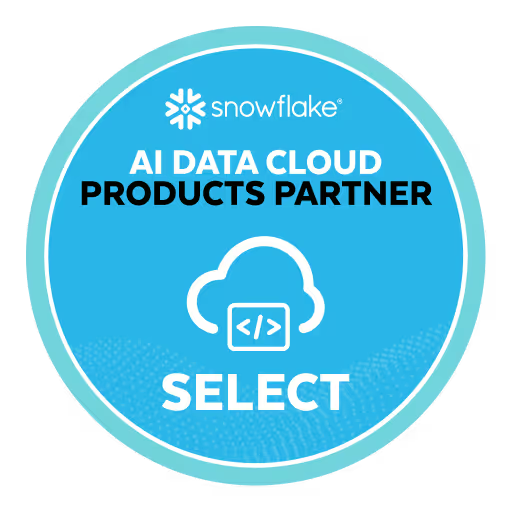Last week, I had the opportunity to participate in a live panel on "From AI to ROI: A Data Executive's Guide to Impactful Enterprise Use Cases” with colleagues from Snowflake, AtScale, Fivetran and Denodo. The conversation reinforced what we have been observing across our customer base at Revefi: there's a massive gap between AI's potential and what most organizations are actually achieving.
The discussion with fellow panelists and the engaged audience surfaced critical questions that data executives are grappling with right now. Here's what we discussed and what I think matters most.
Start with Pain Points, Not Hype
When asked how executives can distinguish genuine AI opportunities from overhyped trends, my answer was simple: start with the use cases. If you can't tie a use case to a measurable business outcome, it's probably hype.
The framework I recommend has three lenses:
- Assess if you even need AI. If something is boring, manual, and can be done faster through automation; you may not need AI for that. Traditional automation will get you there.
- Look for complexity you can collapse. AI excels at taking complex, multi-layered processes and simplifying them. In data management, this means asking: Can I reduce costs? Can I enhance data quality? Can I optimize the underlying performance of my data ecosystem?

- Focus on actionable insights. The real promise of AI, particularly generative AI, is augmenting what automation and predictive AI has already achieved and taking it to the next level.
These opportunities are rooted in real pain points, not in chasing the latest trend.
The Readiness Question: Three Critical Factors
An audience member asked a question that resonates with data leaders: "Most organizations are not ready with a use case, but there is pressure to implement AI. How do you see it?"
This pressure is real. Boards want to see AI ROI, especially where significant investments have already been made. But rushing into AI without the right foundation is a recipe for becoming part of that statistic about failed AI pilots.
Before pursuing any AI initiative, I recommend evaluating three factors:
- Is the use case tied to a customer pain point, and does it actually require AI? This goes back to distinguishing between what needs AI versus what needs good old-fashioned automation.
- Is it solvable with your current team's skills, or do you need to acquire new capabilities? Being honest about this gap early saves tremendous pain later.
- Do you have the right data foundation? This is critical. As data practitioners, we need reliable, well-managed data to support AI initiatives. No AI, no matter how sophisticated or how many billions of tokens it processes, can deliver positive ROI without the right data foundation.
The Build vs. Buy Decision in the AI Era
Another great question from the audience was about when to leverage existing platforms that offer AI capabilities versus building custom solutions.
I will break my response into several paths:
- Do-it-yourself requires an honest impact assessment. What's the opportunity cost? Do you have the right skills? How many people need to sign off? The challenge is you're taking core emphasis away from your business to build something that's essentially a niche capability. And as one panelist noted, it might get thrown away at some point.
- Platform providers are trying to be more horizontal, but most enterprises operate in a multi-platform world. At Revefi, we see customers using Snowflake alongside Databricks and BigQuery. A single platform solution often doesn't address this reality.
- Independent software vendors offer the ability to work across multiple platforms and typically come model-agnostic.
One of my recommendations is to not build a large language model or frontier model on your own unless you have deep pockets and only if there is a clear need. Today’s foundational models are evolving at such a rapid pace, so we decided against building our own LLM. At Revefi, we support OpenAI, Gemini, Claude, and other LLMs.. These platforms can't do what we do because they don't have domain expertise, but we leverage them for what they do best.
Real ROI Looks Different Than You Think

There's been much discussion about the MIT study suggesting 95% of AI pilots don't produce ROI. While there's debate over methodology, the underlying truth is undeniable: many pilots fail to deliver value.
ROI from AI isn't always the headline-grabbing, transformational story that executives want to share at conferences. Often, it's in the mundane, practical applications.
Let me give you real examples from our customers. Today, with generative AI and natural language interfaces, you can query and interact with your data in ways that were never possible before. Imagine wanting to understand:
- Which queries are performing poorly across your warehouses?
- What are the consumption patterns and cost spikes?
- Which teams are writing the most inefficient queries?
Previously, answering these questions would require many person-days. There was simply no practical way to get these insights. Now, through predictive AI insights combined with generative AI interfaces, customers can interact with this data in near real-time.
One of our larger customers is saving over 60% on their data platform costs using Revefi’s predictive AI to analyze their workloads, usage patterns, and queries, which provides optimization recommendations that they can monitor and act on in near real-time. The same applies to data quality, performance, and observability.
AI now is about improving the effectiveness and efficiency of data teams and the underlying data ecosystems. When organizations are spending tens of millions of dollars on data platforms or investing in massive data quality teams, being able to optimize operations and accomplish more in less time represents genuine ROI.
The Natural Language Advantage
One insight from our discussion that deserves emphasis is the interactivity of generative AI and use of natural language interfaces which leads to experimentation. This is actually a strength for organizations under pressure to show AI progress.
For example, a customer was grappling with these. What are the slowest queries? What are the long-running queries? These are problems every data practitioner knows take time to analyze. With natural language interfaces augmenting modern tools enhanced by generative AI, teams can get insights much faster. This approach allows you to reach meaningful outcomes faster.
My Key Takeaway for Executives
If I had to distill everything into one takeaway, it would be to build a proper AI foundation that includes cost management with the right, reliable data as your first AI investment.
No AI, regardless of its sophistication or scale, can deliver positive ROI without reliable data and effective data management.
The organizations succeeding with AI aren't the ones chasing every new capability. They're the ones who have shifted from manual, siloed data management to a more unified, self-driving approach. They're the ones treating their data infrastructure as a strategic foundation, not an afterthought.
That foundation enables everything else - from the efficiency gains to the transformational business insights. Get that right, and the ROI from AI follows naturally.
You can watch the entire webinar here.
Learn More
To learn more about how leading enterprises like AMD, Verisk, Stanley Black & Decker, Ingersoll-Rand, and Ocean Spray are using Revefi to maximize the ROI of their data stacks, request a free value assessment today.











